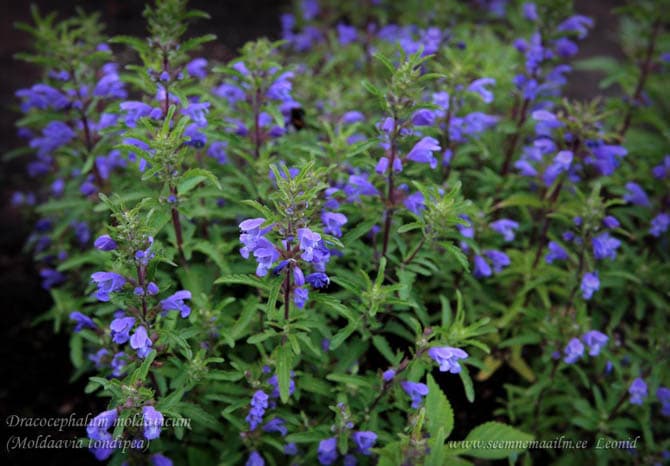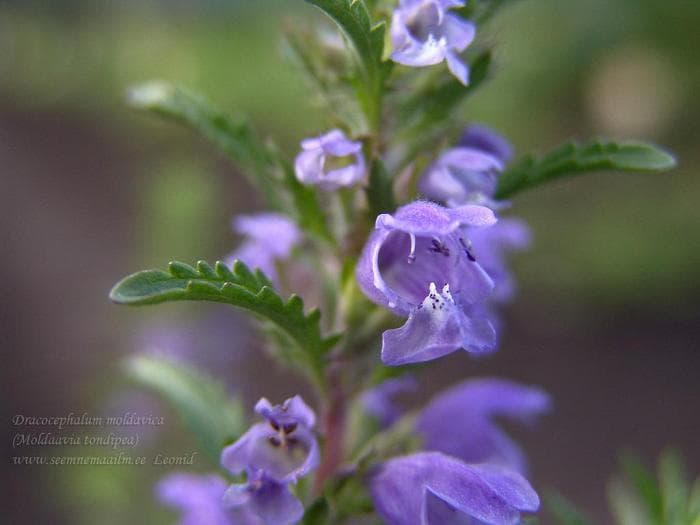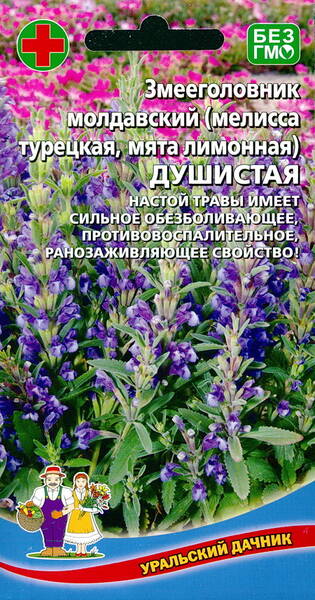Black Friday!
Discount on all products -23% only November 28-30!
Ex Tax: 1.11€
A harmonious combination of taste and healing qualities! Tones, heals, attracts bees!
An annual herbaceous plant of the Lamiaceae family. Sowing in mid-May - early June. Seeds germinate at a temperature of +5+7°C. Seedlings and adult plants endure a long cold snap. In the initial period of growth, the snakehead makes increased demands on moisture. Planting seedlings after 30-35 days according to the scheme 30x50 cm. Blooms in July.
The plant is photophilous, undemanding to soils and heat. The stem is erect, tetrahedral, branched, 50-70 cm high. The leaves are short-petiolate, opposite, oblong-ovate or oblong-lanceolate, serrated along the edge, dark green; apical leaves lanceolate. Flowers are pale purple. The leaves and the plant itself have a pronounced lemon flavor and can be used as a substitute for lemon balm and catnip in dishes and drinks. The weight of one plant is about 240 g, the yield is 1.8 kg/m2.
The number of seeds in 1 gram of the Moldavian dragonhead = 460-510 pieces.

* The dragonhead does not differ in special beauty (height is about 50-80 cm). But the smell of this plant is wonderful! The snakehead occupies one of the leading places in aroma and herbal medicine, but so far, unfortunately, it is rarely grown in gardens - but it's worth it.
The pleasant fresh mint-lemon smell of moldavian dragonhead buds and leaves, collected before flowering, is also preserved in dried form (for three years).
Fresh and dried dragonhead leaves are used as a spice and added to a variety of dishes, as a seasoning for meat, game and vegetables, as an integral part of fragrant herbs when pickling cucumbers and tomatoes. Serpentine head is also added to drinks (tea, compote), in the preparation of liqueurs and flavoring of vinegar.
The flowers of the dragonhead, when viewed closely, are very elegant, they are light purple, dark blue or white. With an abundance of nectar, these flowers attract many bees to the garden.
The dragonhead is very easy to grow, as it is an early maturing and relatively cold-resistant plant. In April-May, dragonhead seeds are planted directly in the ground (without soaking, otherwise mucus is released from the seeds and they stick together!).
This plant is suitable for any fertile and moderately moist soil, except for acidic and marshy, bright place.
At first, the shoots of the moldavian dragonhead develop slowly, they need to be thinned out (10 cm apart), but then the bushes grow very quickly and bloom.
Remember to leave a few bushes for seeds (do not cut leaves and buds from them). With a strong increase in the seed of the dragonhead (trihedral nut) resembles the head of a snake - from this similarity the name of the plant originated.

Moldavian dragonhead, Moldavian balm, Moldavian dragon's head. Bot. syn.: Moldavica moldavica (L.) Britt.
Tones, heals, attracts bees!
Flowers and foliage, fresh and dried, are used as a spice to flavor various dishes, tea, and when canning vegetables.
Infusion and decoction are a good strengthening, tonic and astringent. Dracocephalum moldavicum (dragonhead) used for colds.
The greens are cut during the flowering period and dried under a canopy. Sowing seeds directly into open ground to a depth of 1.5-2 cm. Shoots appear on days 12-15. Loves light and moisture.
In July, beautiful purple flowers appear on the tops of the Moldavian balm shoots, the shape of which, with a certain amount of imagination, resembles the head of a dragon. They are eagerly visited by bees, who flock to the plants in swarms.
Powerful tetrahedral stems grow vertically upward, reaching a height of 30-60 cm. They bear beautiful leaves with carved edges. When you touch them, you feel a pleasant aroma reminiscent of lemon.
When sowing seeds in March or April, young plants begin to bloom in July and finish in the fall. As they grow, the stems bend and even press against the ground, but their tops, which bear flowers, always straighten and look vertically upward. It looks very decorative, especially when planting dragonheads in containers.
In March, seeds are sown indoors, and in April - in open ground. Plants are placed in a sunny location with nutrient-poor soil.
The essential oil obtained from the Moldavian dragonhead is a transparent liquid of light yellow color with a lemon smell and is used in the perfumery and cosmetics industry in the production of high-quality soaps, creams and perfumes.
The plant is used in the confectionery and canning industries, as well as in the production of vermouth and for flavoring soft drinks. Fresh and dried leaves and flowers, which have a lemon scent, are used in cooking. The spice is added to summer salads, fish broth, rassolnik and other soups. The plant imparts a piquant aroma to meat and fish dishes. Homemade sausages are flavored with dried leaves powder. Dragonhead is put in tea, compotes, and bread kvass. The filling rate for 1 serving is 0.2-0.4 g.
Spice is added to liquid dishes 3 minutes before serving.
The herb (stems, leaves, flowers) is used for medicinal purposes. Essential oil, tannins, coumarins, and the flavonoid moldavoside were found in the aerial part of the plant.
The leaves and flowers contain essential oil, vitamin C, and the inflorescences contain essential oil.
A decoction of the herb in clinical trials for pyelonephritis in children gave positive results and is recommended for treatment.
And the tincture, as the experiment showed, increases the tone and increases the amplitude of intestinal contractions in vitro, dilates the vessels of the mesentery and increases the speed of blood flow.
The herb extract exhibits antibacterial activity.
In folk medicine, an aqueous infusion of the Moldavian dragonhead herb is used as an anti-inflammatory, wound-healing, analgesic, sedative, anticonvulsant, antispasmodic, as well as for dysfunction of the gastrointestinal tract, to stimulate appetite, for women's diseases, rapid heartbeat, neuralgia, migraine, headache pain, aches due to colds.
A decoction of the seeds is used as an astringent, sedative, and for flatulence. Fresh crushed leaves accelerate the healing of purulent wounds.
For rheumatism or bruises, apply herbal compresses to the sore spot.
Infusion and decoction of the herb is used as a tonic and astringent for hepatitis, gastritis, nephritis, and for stomatitis - as a rinse.
Recipes:
• 1 tbsp. spoon of dry crushed herbs per 1 cup of boiling water. Leave for 20-25 minutes in a sealed container, strain.
Take 1-2 tbsp. spoons 15 minutes before meals 3-4 times a day for palpitations.
• 1 tsp. spoon of seeds in 1 glass of water, boil over low heat for 3-4 minutes, leave for 2 hours, strain.
Take 2 tbsp. spoons 3-4 times a day for migraines.
Vinegar infused with dragonhead and lavender.
Add Moldavian balm and lavender sprigs to a mixture of vinegar and white wine. Leave for 14 days in a dark and cool place. Use on salads.
Dragonhead - 2 large sprigs, lavender - 1-2 sprigs, a mixture of vinegar and white wine (1:10) - 0.5 l.
Fire vinegar.
Cut the onion in half, remove seeds and cores from the pepper. Add dragonhead, add vinegar, leave for 2-3 weeks. For salads, dumplings, etc. Use with caution!
Hot green pepper - 1 pod, shallots - 5 pcs., moldavian balm - 3 large branches, wine vinegar - 0.5 l.
Fragrant tea.
Add a little chopped dragonhead to regular tea. The tea will acquire a pleasant lemony smell with a mint flavour.
Tea from the herb of the Moldavian balm in Chinese.
Boil 250 ml of water. Rinse the teapot with boiled water. Place 3-5 g of dried snakehead herb into a kettle, cover with a lid, and leave for 30 seconds. Pour in the remaining water and cover with a lid. Let cool slightly.













